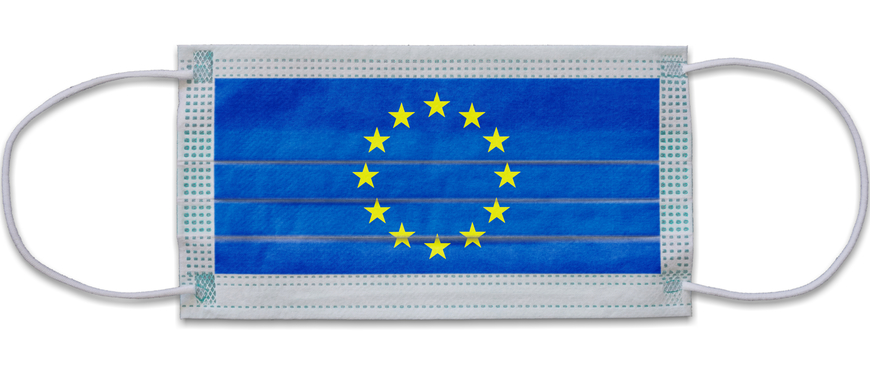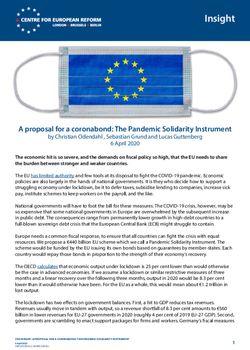
A proposal for a coronabond: The Pandemic Solidarity Instrument
The economic hit is so severe, and the demands on fiscal policy so high, that the EU needs to share the burden between stronger and weaker countries.
The EU has limited authority and few tools at its disposal to fight the COVID-19 pandemic. Economic policies are also largely in the hands of national governments. It is they who decide how to support a struggling economy under lockdown, be it to defer taxes, subsidise lending to companies, increase sick pay, institute schemes to keep workers on the payroll, and the like.
National governments will have to foot the bill for these measures. The COVID-19 crisis, however, may be so expensive that some national governments in Europe are overwhelmed by the subsequent increase in public debt. The consequences range from permanently lower growth in high-debt countries to a full-blown sovereign debt crisis that the European Central Bank (ECB) might struggle to contain.
To ensure that all EU countries can do what is necessary to fight the economic fallout of #Covid19, fiscal costs must be shared.
Europe needs a common fiscal response, to ensure that all countries can fight the crisis with equal resources. We propose a €440 billion EU scheme which we call a Pandemic Solidarity Instrument. The scheme would be funded by the EU issuing its own bonds based on guarantees by member-states. Each country would repay those bonds in proportion to the strength of their economy’s recovery.
The OECD calculates that economic output under lockdown is 25 per cent lower than would otherwise be the case in advanced economies. If we assume a lockdown or similar restrictive measures of three months and a linear recovery over the following three months, output in 2020 would be 8.3 per cent lower than it would otherwise have been. For the EU as a whole, this would mean about €1.2 trillion in lost output.
The lockdown has two effects on government balances. First, a hit to GDP reduces tax revenues. Revenues usually move in tandem with output, so a revenue shortfall of 8.3 per cent amounts to €560 billion in lower revenues for EU-27 governments in 2020 (roughly 4 per cent of 2019 EU-27 GDP). Second, governments are scrambling to enact support packages for firms and workers. Germany’s fiscal measures amount to more than 4 per cent of its GDP so far. Later on, when restrictions are gradually lifted, countries will have to put in place sizable stimulus packages.
But the impact of COVID-19 on EU member-states will be asymmetric. First, the health impact may be different across countries, for various reasons. Italy was unfortunate to be the first European country hit, with only China to learn from about how to contain the virus. Second, countries depend on different sectors of their economies. Manufacturing stands a good chance of making a relatively swift recovery after pent-up demand returns when restrictions are eased. Services, on the other hand, stand to suffer for longer: customers may continue to fear infection, and are less likely to make up for foregone holidays, for example. Third, countries start from different positions. Before the pandemic struck, Italy was struggling to grow and labouring under a debt burden of over 130 per cent of GDP. In Spain, unemployment stood at 14 per cent a decade after the financial crisis.
The Pandemic Solidarity Instrument
We propose a one-off EU instrument that is tailored to the pandemic. It would not create a new institution for either the EU or the eurozone. The aim is to ensure that the pre-existing institutional setup has a reasonable chance of surviving this crisis, and that countries have the certainty they need now to be able to act boldly. The instrument is not limited to the eurozone, but would cover the entire EU. The legal framework it is based on is for the EU, not the eurozone, and the issue of economic divergence after this crisis affects the whole EU, not just the eurozone.
The EU should borrow on its own account, backed by guarantees, to fund the fight against the economic fallout of #Covid19.
Through our Pandemic Solidarity Instrument, the EU would raise the necessary funds on markets on its own account, meaning that the Union, not the member-states, would borrow. To do so, it would need to receive irrevocable and unconditional guarantees from member-states, which requires votes in some national parliaments. (The treaties severely restrict EU borrowing without guarantees to around 0.2 per cent of GDP.) These guarantees would not count towards individual states’ public debt, as they would be a guarantee to an institution with its own capacity to act, and not to a pure accounting vehicle.
The legal basis for the instrument is Article 122(1) of the Treaty on the Functioning of the EU, which allows the Commission to propose and the Council to decide upon "the measures appropriate to the economic situation in a spirit of solidarity between member-states". Since our proposal goes beyond financial assistance such as loans, it is not based on Article 122(2), which had been used before during the euro crisis. Article 122(1) gives the EU wide discretion to act in the spirit of solidarity, also to override provisions in Article 310 that the EU must always balance its books: Article 311 states that the EU “shall provide itself with the means necessary to attain its objectives and carry through its policies“, which in this emergency should include debt that is guaranteed by the member-states.
An EU Pandemic Solidarity Instrument should spend on health care, short-time work schemes and unemployment benefits, EIB liquidity support and a post-crisis stimulus.
The EU should raise €440 billion on debt markets. It should spend those funds in four ways, none of which would count as public debt of the receiving member-state. First, €20 billion should be spent to cover costs directly related to fighting the virus, such as investment in medical equipment and hospital capacity. The EU would cover 80 per cent of eligible expenditures.
Second, €120 billion should fund the European Investment Bank (EIB). The EIB has proposed an EU-wide scheme to support firms with liquidity during this crisis. It has asked for €25 billion in guarantees to fund liquidity support of about €200 billion. But Germany’s liquidity programme (via its public investment bank KfW) already had an initial volume of about €465 billion (and is now unlimited). As Germany makes up a quarter of the EU economy, an EU-wide scheme should aim for €1.8 trillion in liquidity support for firms, of which half should come from the EIB. That would require €120 billion in new EIB guarantees.
Third, €100 billion should fund a new European labour market re-insurance scheme based on grants, not loans. Labour markets in Europe will need support for the unemployed and subsidies to keep workers on the payroll, along the lines of the Germany’s 'Kurzarbeit' (short-work) scheme. Such schemes already exist in many member-states and could be introduced in more. For every worker that is furloughed under such a scheme, the EU should contribute up to 40 per cent of the net salary as long as member-states match this one-to-one. In addition, all member-states should receive a subsidy of short-term unemployment benefits of up to 25 per cent of the net salary. That subsidy must be matched by the member-state for the first six months of unemployment. It is difficult to predict the cost of this scheme. Based on German figures so far, we assume that the uptake of short-time work and unemployment support will be three times as high as in 2009. Taken together, these figures lead us to estimate a minimum EU-wide need of about €30 billion for short-term work schemes and about €70 billion for short-term unemployment benefits, bringing funding needs to €100 billion.
Fourth, all countries will need to deploy substantial fiscal stimulus once containment measures can be lifted. The EU should support such measures: our Instrument would fund 50-75 per cent of eligible fiscal stimulus measures such as temporary VAT cuts or boosts to public investment. The overall spending per country should be calculated based on the GDP shortfall in the first half of this year. And the more dependent the economy is on sectors that are unlikely to see catch-up effects, the larger co-financing should be. Italy and Spain will be severely hit if tourists stay away in the summer season. This way, countries that are hit hardest and are most likely to struggle during the recovery will receive the most. We assume that the necessary stimulus will be 2 per cent of EU GDP. With an average co-financing of 65 per cent, the instrument would need €200 billion.
The bonds that the EU would issue to fund the instrument should have long maturities of 20-50 years. These bonds could be rolled over when they come due, should all member-states agree to do so. But the legal act underpinning the instrument would specify how the bonds should be repaid. We propose a simple solution: member-states should repay not according to their share of the guarantees, but according to their share in EU GDP at the time of repayment. As a result, the strong would support the weak by paying more for the COVID-19 response.
The Pandemic Solidarity Instrument is bold but institutionally and legally feasible. It fills a gap left by the EU budget, which is currently unequipped in both size and structure to provide the kind of burden-sharing across the entire Union that is needed. However, it does not solve the fiscal side of this crisis completely. Countries will still need to fund large deficits in markets. Ideally, our fiscal instrument would be combined with generous funding offers by the European Stability Mechanism (ESM), the eurozone bailout fund, to the hardest hit countries, to leave no doubt that Europeans are in this together. This is also in the interest of the rich countries: there is nothing to gain from an economic crisis in Europe, and much to lose from a political one.
Sebastian Grund is Fulbright Scholar at Harvard Law School, Lucas Guttenberg is deputy director at the Jacques Delors Centre and Christian Odendahl is chief economist at the Centre for European Reform. This insight is a summary of the proposal which was published on VoxEU here.




Add new comment